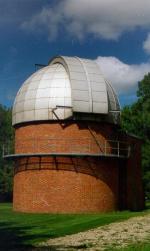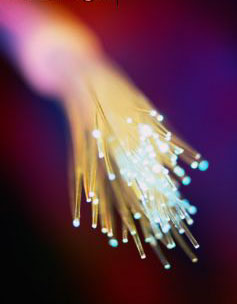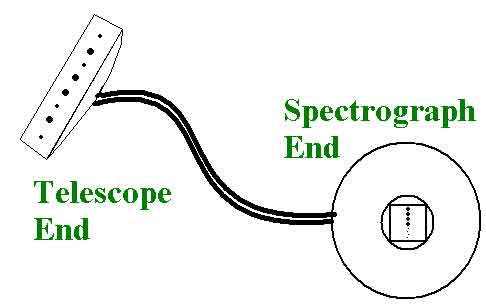| Warner and Swasey Observatory |
| Case Western Reserve University | Nassau Station |
| Visitors |
|
» Home » News » Gallery » Reference » Weather |
| Science Resources |
|
» NSRT User Interface » Software » Data Archive » Download Data |

|
 |
Fiber Optics
 What are Fiber Optics?
What are Fiber Optics?
Fiber optics are thin transparent fibers that are used to transmit light quickly over long distances. A common use of fiber optics that you encounter every day are their use to transmit long distance telephone communications or connect computers on some fast computer networks. You may have also seen them used in sculpture or other works of art. More recently fiber optics have been used in medicine to allow doctors to probe inside patients through a small incision in the skin or transmit laser light to break up bladder stones, remove tumors, or unblock clogged arteries.
Fiber optics are normally single drawn strands of glass that are no thicker than a human hair. The individual fibers are coated in a thin "cladding" that protects the glass and causes any light exiting the glass to be reflected back into the fiber. With this setup light going in one end of the fiber can be transmitted very long distances with little or no loss of light.
Why does the NSRT use fiber optics?
Our spectrograph (see the reference on spectra) is not attached to the back of the telescope for practical mechanical reasons but we still need to get the light from the telescope to the spectrograph. In the past this was done with a chain of mirrors that reflected the light along a path to the spectrograph. The draw back of this setup is that mirrors are only 60%-80% efficient at reflecting light so every time you had to use another mirror you lost 20%-40% of the light your telescope had gathered. A typical system might contain four mirrors, meaning you lost about half your light on the way to the spectrograph. Astronomers hate to waste light like this because it keeps you from looking at anything but the very brightest objects. In addition, the air between the mirrors would scatter light out of the beam from the telescope and cause even more light to be lost.
Fiber optics have none of these drawbacks. The light is transmitted through the glass of the fiber with only 10%-20% light loss over the entire length of the fiber. (To be honest, there is almost no light loss inside the fiber, with most of the losses occurring at the ends where the light enters and exits the fiber.)
The fiber optic also preserves the F-ratio of the light entering it from the telescope. The light in the focal plane of the telescope is at a perfect focus, but ahead of or behind that focus the light beams are spreading apart. (see the light path diagrams in the reference on telescopes) The amount of spread in these beams as you get further from the focus determines the telescope's F-ratio. If you use mirrors to get the light from the back of the telescope to the spectrograph, along the beam you have to use larger and larger mirrors as your get further from the telescope to accommodate the spreading light beam. Large mirrors can be expensive. The first mirror in the spectrograph, the collimator, has to be specially figured (an off-axis paraboloid) so a very large collimator can be prohibitively expensive.
The collimator on the NSRT spectrograph does not have to be large (only 4 inches in diameter) because we are using fiber optics. The properties of fiber optics are such that when the light exits the fiber and enters the spectrograph, the path it takes is as if the fiber was not even there and the spectrograph was attached right to the end of the telescope.
So fiber optics allow us to get more light from the back of the telescope into the spectrograph and also let us save money on large specially built mirrors. Well, we don't save that much money because fifty feet of high quality fiber optics are not exactly cheap.
What is the fiber setup for the NSRT Spectrograph?
 For the spec sheet on our fiber optics, visit http://www.polymicro.com/fipage.htm. We have purchased ultra-low OH content fibers (which means little or no water trapped in the fiber) because water in the fiber can absorb light at wavelengths we are interested in and we want all wavelengths of light equally transmitted through the fiber. This matters for astronomy but not for most other applications of fiber optics.
For the spec sheet on our fiber optics, visit http://www.polymicro.com/fipage.htm. We have purchased ultra-low OH content fibers (which means little or no water trapped in the fiber) because water in the fiber can absorb light at wavelengths we are interested in and we want all wavelengths of light equally transmitted through the fiber. This matters for astronomy but not for most other applications of fiber optics.
There are eight individual fibers in our fiber optic cable (which with protective insulation and everything is only about half the diameter of a #2 pencil). Not all of the fibers in the cable are identical. Four of the fibers are of a large diameter (125 microns) and four are small diameter (62.5 microns). The large fibers let more light in at the telescope end but the large fibers are bigger than the size needed to get the maximum spectral resolution out of the spectrograph so the small fibers are used to obtain spectra with full resolution. So the large fibers will be used for lower spectral resolution and fainter objects and the small fibers will be used for higher spectral resolution and brighter objects.
On the end of the fiber attached to the telescope we have laid out the fibers in a straight line from east to west. The order from east to west is small, large, small, large, large, small, large, and small. The spectrograph end of the fibers is ordered differently so that the four large fibers appear on the top of the CCD and the small fibers appear on the bottom.